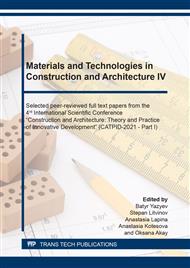[1]
T.V. Eferina, K.V. Khilov, The market of dry building mixtures: specificity of promotion, Building materials – Business. 8 (2005) 10-11.
Google Scholar
[2]
Analysis of dry mortar in Russia in 2015–2019, assessment of the impact of coronavirus and forecast for 2020–2024. Information on https://businesstat.ru/images/demo/dry_building_mix_ russia_demo_businesstat.pdf.
Google Scholar
[3]
Dry mortar market in Russia: research and forecast up to 2025. Information on https://roif-expert.ru/stroitelstvo/stroitel-nye-smesi/rynok-suhih-stroitel-nyh-smesej/rynok-suhih-stroitel-nyh-smesej-v-rossii-issledovanie-i-prognoz.html.
Google Scholar
[4]
E.N. Botka, The market of dry building mixtures: from rapid growth to tough competition, StroyPROFil. 6-06 (2006). Information on http://stroyprofile.com/archive/2347.
Google Scholar
[5]
V. Erofeev, V. Smirnov, A. Dergunova, A. Bogatov, N. Letkina, Development and Research of Methods to Improve the Biosistability of Building Materials, Mater. Sci. Forum. 974 (2020) 305-311.
DOI: 10.4028/www.scientific.net/msf.974.305
Google Scholar
[6]
A. Dergunova, A. Piksaykina, A. Bogatov, A. Salman, V. Erofeev, The economic damage from biodeterioration in building sector, IOP Conf. (Ser.: Mater. Sci. Eng.). 698(7) (2019) 077020.
DOI: 10.1088/1757-899x/698/7/077020
Google Scholar
[7]
V.T. Erofeev, A.D. Bogatov, V.F. Smirnov, S.N. Bogatova, V.I. Rimshin, V.L. Kurbatov, Bioresistant building composites on the basis of glass wastes Biosciences Biotechnology, Research Asia. 12(1) (2015) 661-669.
DOI: 10.13005/bbra/1710
Google Scholar
[8]
L.N. Shafigullin, A.A. Bobrishev, V.T. Erofeev, A.A. Treshchev, A.N. Shafigullina, Development of the recommendations on selection of glass-fiber reinforced polyurethanes for vehicle parts, Int.l J. of Applied Eng. Research. 10(23) (2015) 43758-43762.
Google Scholar
[9]
V. Erofeev, V. Kalashnikov, S. Karpushin, A. Rodin, V. Smirnov, O. Smirnova, M. Moroz, V. Rimshin, I. Tretiakov, A. Matvievskiy, Physical and mechanical properties of the cement stone based on biocidal Portland cement with active mineral additive, Solid State Phenomena. (2016) 28-32.
DOI: 10.4028/www.scientific.net/msf.871.28
Google Scholar
[10]
V. Erofeev, V. Kalashnikov, D. Emelyanov, E. Balathanova, I. Erofeeva, V. Smirnov, I. Tretiakov, A. Matvievskiy, Biological resistance of cement composites filled with dolomite powders, Solid State Phenomena. 871 (2016) 33-39.
DOI: 10.4028/www.scientific.net/msf.871.33
Google Scholar
[11]
V. Erofeev, V. Kalashnikov, D. Emelyanov, E. Balathanova, I. Erofeeva, O. Smirnova, I. Tretiakov, A. Matvievskiy, Biological resistance of cement composites filled with limestone powders, Solid State Phenomena. 871 (2016) 22-27.
DOI: 10.4028/www.scientific.net/msf.871.22
Google Scholar
[12]
V. Erofeev, Frame Construction Composites for Buildings and Structures in Aggressive Environments, Procedia Eng. 165 (2016) 1444–1447.
DOI: 10.1016/j.proeng.2016.11.877
Google Scholar
[13]
A. Bulgakov, V. Erofeev, A. Bogatov, V. Smirnov, R. Schach, Innovative production technology of binding and building composite materials on the basis of glass wastes, Insights and Innovations in Structural Engineering, Mechanics and Computation – Proceedings of the 6th Int. Conf. on Structural Engineering, Mechanics and Computation, SEMC 2016 (2016)1583-1586.
DOI: 10.1201/9781315641645-260
Google Scholar
[14]
A.A. Panchina, I.R. Kildeev, I.P. Tereshkin, Effective additives for raw cement mixtures based on natural zeolite-containing rocks of mordovia republic, Ogarev-online 5 (2016). Information on http://journal.mrsu.ru/arts/effektivnaya-dobavka-dlya-cementnyx-syrevyx-smesej-na-osnove-prirodnyx-ceolitosoderzhashhix-porod-respubliki-mordoviya.
Google Scholar
[15]
V.I. Wentzel, Probability theory, Nauka, Moscov, (1969).
Google Scholar
[16]
Yu.A. Evdokimov, V.I. Kolesnikov, A.I. Teterin, Planning and analysis of experiments in solving problems of friction and wear, Nauka, Moscov, (1980).
Google Scholar
[17]
P.V. Zozulya, Carbonate rocks as fillers and fillers, in cements, cement mortars and concretes, (2017). Information on https://docplayer.ru/42261735-Karbonatnye-porody-kak-zapolniteli-i-napolniteli-v-cementah-cementnyh-rastvorah-i-betonah.html.
Google Scholar
[18]
V.I. Solomatov, A.V. Sirenko, V.N. Vyrovoy, V.I. Litvyak, Concrete with fillers, Composite building materials, Saransk,1987, 20-22.
Google Scholar
[19]
L.I. Dvorkin, I.B. Shabman, S.M. Chudnovsky [et al.], High-strength concrete using fly ash, Concrete and reinforced concrete. 1 (1993) 23-25.
Google Scholar
[20]
L.B. Goldenberg, S.L. Oganesyants, Application of TPP ash to improve the properties of fine-grained concrete, Concrete and reinforced concrete. 1 (1987) 15-17.
Google Scholar
[21]
Yu.M. Bazhenov, Technology of concrete, Higher school, Moscow, (1978).
Google Scholar


